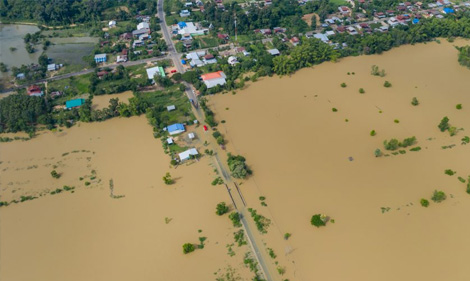

Mitigating Flooding Impacts on Drinking Water Treatment Systems

We've talked in the past about how drought conditions can negatively impact drinking water systems. However, to the inverse, there are also problems and challenges caused by an overabundance of water flooding a system. This article will reveal how flooding can negatively impact drinking water treatment systems. It will also identify and discuss prevention and mitigation measures that can be taken to reduce or eliminate flooding impacts on a water treatment system.
How Floods Contaminate Drinking Water
Drinking water starts with a source, that source could be surface water or groundwater. Floods can contaminate both sources. Increased water flow during a flood often makes rivers and streams very cloudy. The cloudiness increases turbidity and is caused by silt run off and other particulates entering the water body. Groundwater sources are contaminated when particulates enter the wellhead or the areas immediately around the wellhead during flooding.
Flood waters may inundate a treatment facility and wash out open tanks, damage mechanical equipment, and render electrical power and controls useless. Flooding can also spoil finished water storage tanks and wash contaminants directly into the treatment process. The elevated turbidity caused by silt and other contaminants can also render a treatment plant system ineffective by clogging filters, pumps, and lines. Even if your water system can overcome high turbidity, the change in disinfection levels may cause taste or odor problems in the treated water.
Prevention and Mitigation Measures
Ideally, we would all like to prevent flooding and protect structures, especially over mitigating impacts. Prevention can be as simple as implementing a program to keep all drains and culverts clear of debris to reduce flooding. Other simple measures to prevent flooding are having sandbags readily available to implement as a physical barrier, planting green infrastructure, or digging channels to divert or retain flood water. More complex, and more expensive, measures include constructing levees and flood water pumping systems with culverts to collect and divert flood water away from treatment processes.
As good as some prevention methods are, it is advised to have mitigation measures in place in the event of an emergency. Mitigation measures can be any emergency planning activity, equipment modification, or new capital construction project. Again, these measures can be as simple as a plan to move vehicles to high ground or filling finished water storage tanks to full capacity if a flood is anticipated. Another simple measure is to maintain sufficient supplies of chemicals and fuel in anticipation of supply disruptions during a flood. Lastly, a phone call to the electric company to plan for priority restoration of power to your water treatment facility may be necessary.
More costly and involved mitigation measures include elevating storage and chemical tanks and electrical components and increasing side wall height of tankage. Having backup power on standby and increasing fuel supply tank size is another way to mitigate the effects of power loss from flooding. Having backup portable meters to monitor the quality of raw water entering the treatment plant and being prepared to adjust the treatment process as necessary to account for increased turbidity is an essential part of a mitigation measure.
Whatever prevention or mitigation measures you choose, act now. Start asking questions and assessing how your water treatment plant would fare during a flood. This natural disaster is not something we think about daily, but it is better to have a plan and assets in place before the rain comes.